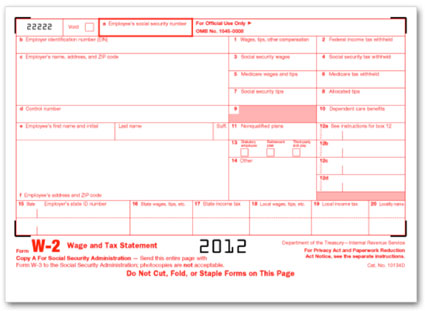What is a W-2 Form?

A W-2 form shows the amount of taxes withheld from your paycheck for the year and is used to file your federal and state taxes. Here are the basics.
The IRS requires employers to report wage and salary information for employees on Form W-2. Your W-2 also reports the amount of federal, state and other taxes withheld from your paycheck. As an employee, the information on your W-2 is extremely important when preparing your tax return. To insure you have it in time, the IRS requires your employer to send you a W-2 no later than January 31 following the close of the tax year, which is usually December 31.
W-2 wages and withholding
You should only receive a W-2 if you are an employee. If you are an independent contractor or self-employed, the work you do may be the same as an employee, but you will receive an earnings statement on a Form 1099 rather than a W-2.
The W-2 form is divided into boxes that report various items relating to your income. In box 1 of the W-2 you will find your annual wage and salary payments with the amount of federal tax withheld from it in box 2.
Since only a portion of your income is subject to the Social Security tax, you may find that box 3 reports an amount that is less than your total wages for the year. Other boxes on the W-2 form include your wages subject to Medicare tax, Social Security taxes that are withheld and information on your state income tax withholding, if applicable.
Importance of your tax withholding
When your employer withholds amounts from your paycheck for federal income taxes, those amounts are remitted to the IRS throughout the year. You may not realize it, but in most cases, you cannot wait until April 15 to pay your entire tax bill. The IRS requires everyone to make periodic payments throughout the year; however, your employer takes care of this for you.
When you prepare your federal return and calculate your tax for the year, the withholding amount your employer reports on the W-2 must be subtracted from your tax bill. Once you perform this calculation, you will know whether to expect a refund or make an additional tax payment. If you file a state income tax return, the same calculation is necessary for the amount withheld to pay your state income taxes.
Verifying your name and Social Security number
The identifying information section of the W-2 is essentially a tracking feature. If the income you report on your taxes does not match the information on your W-2, the IRS will want to know why. Similarly, the IRS will match the reported payment amounts with your employer's corporate tax return for accuracy.
But most importantly, since the IRS receives a copy of your W-2, it already knows whether you owe tax and may contact you if you fail to file a tax return. If the name or Social Security number on your W-2 is inaccurate, you should immediately report this to your employer to correct.
Attaching your W-2
When you finish your tax returns and get ready to file them, remember that a copy of your W-2 must always be attached. If you e-file using TurboTax then your W-2 information is sent along with your tax return. However, if you are filing your tax return by mail then you to place a copy on the front of your return.
How to Get All of the Tax Deductions Possible When Filing
Watch this TurboTax Tips video to find out!
Tax Law Changes: What You Need to Know for 2012
New Tax Law: American Tax Relief Act of 2012 On New Year's Day 2013, Congress passed the much-talked about fiscal cliff tax legislation, The American Tax Relief Act of 2012, which was signed by President Obama.

